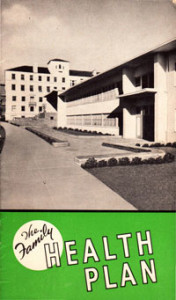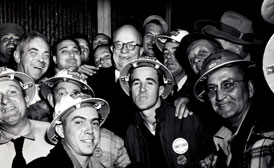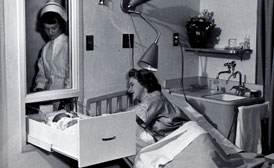On July 21, 2015, Kaiser Permanente celebrated 70 years of providing access to quality and affordable health care to the public.
The organization got its start at the height of the Great Depression with a young surgeon pioneer, Sidney Garfield, MD, who refused to turn away any sick or injured worker at his Contractors General Hospital in California’s Mojave Desert. As it is today, the cost of basic health care back then was a tremendous burden, yet Dr. Garfield took it upon himself to establish a means for these workers to pay into health coverage at a minimum fixed rate.
Fast forward  a few years to World War II, when Dr. Garfield and Henry J. Kaiser, American industrialist and creator of the Kaiser Shipbuilding Company, created an innovative health care delivery system at the shipyards in Richmond, California and the Portland, Oregon area, as well as the new Fontana steel mill in Southern California. Out of this inspired partnership, Kaiser Permanente was born.
a few years to World War II, when Dr. Garfield and Henry J. Kaiser, American industrialist and creator of the Kaiser Shipbuilding Company, created an innovative health care delivery system at the shipyards in Richmond, California and the Portland, Oregon area, as well as the new Fontana steel mill in Southern California. Out of this inspired partnership, Kaiser Permanente was born.
By the end of 1945, after losing almost all of its wartime workforce, Kaiser Permanente was caring for 26,500 members. Now, 70 years later, the organization is caring for more than 10 million members.
Kaiser Permanente has accomplished many great things over the course of its rich history, including pioneering health information technology and broadly sharing knowledge and research. These advances benefit not only the organization’s members and patients, but also help solidify its role in the future of health care.
Kaiser Permanente has made a difference in the lives of our members and communities over the past seven decades. Some of the areas and accomplishments that make Kaiser Permanente unique include:
Henry J. Kaiser’s long history of supporting labor — an ethical and business decision he’d come to when handling huge government contract projects such as the Grand Coulee Dam (1938-1941) and World War II shipbuilding (1941-1945) — proved beneficial when unions insisted on the plan for their members. Labor unions were prominent among the early member groups of the public plan. Key support came from major labor groups such as the International Longshoremen and Warehousemen’s Union and the Retail Clerks International Union.
During WWII, the novel use of penicillin by Morris Collen, MD, in the Kaiser shipyards not only saved lives, it provided sound medical evidence for future treatment methods. In the mid-1950s, Kaiser Permanente’s “Hospitals of the Future” boasted features such as separate staff and patient corridors, built-in lavatories, remote-controlled curtains and the “baby in a drawer” bassinet that slid between the patient’s room and nursery.
A Model for National Care
The WWII Permanente health plan was so efficient and effective that Henry J. Kaiser proposed it to the U.S. Government as a model for national health care. And we have been contributing to the conversation of improving the state of the nation’s health ever since.
Nondiscrimination
Kaiser Permanente has been recognized for being one of the first health care providers in the United States to have racially integrated hospitals and waiting rooms, as well as an ethnically diverse workforce, including physicians and allied health professionals.
Physician Leadership
Our health plan was forged from the powerful collaboration of a brilliant industrialist and a gifted physician. The pivotal Tahoe Agreement of 1955 would refine the underlying working partnership that continues to this day, whereby physicians would take care of medical matters and the Health Plan and Hospitals would be responsible for the nonprofit facilities and programs.






